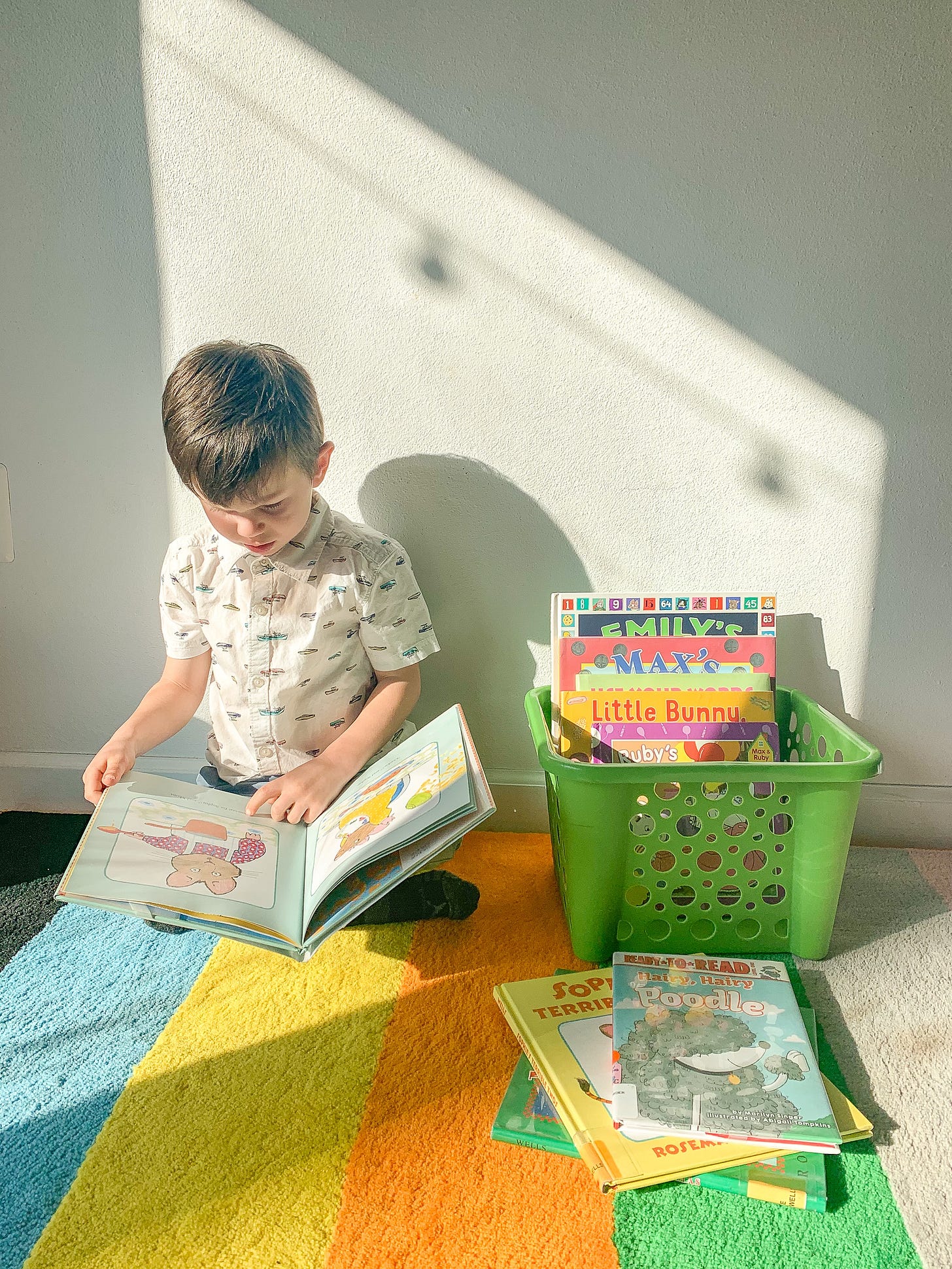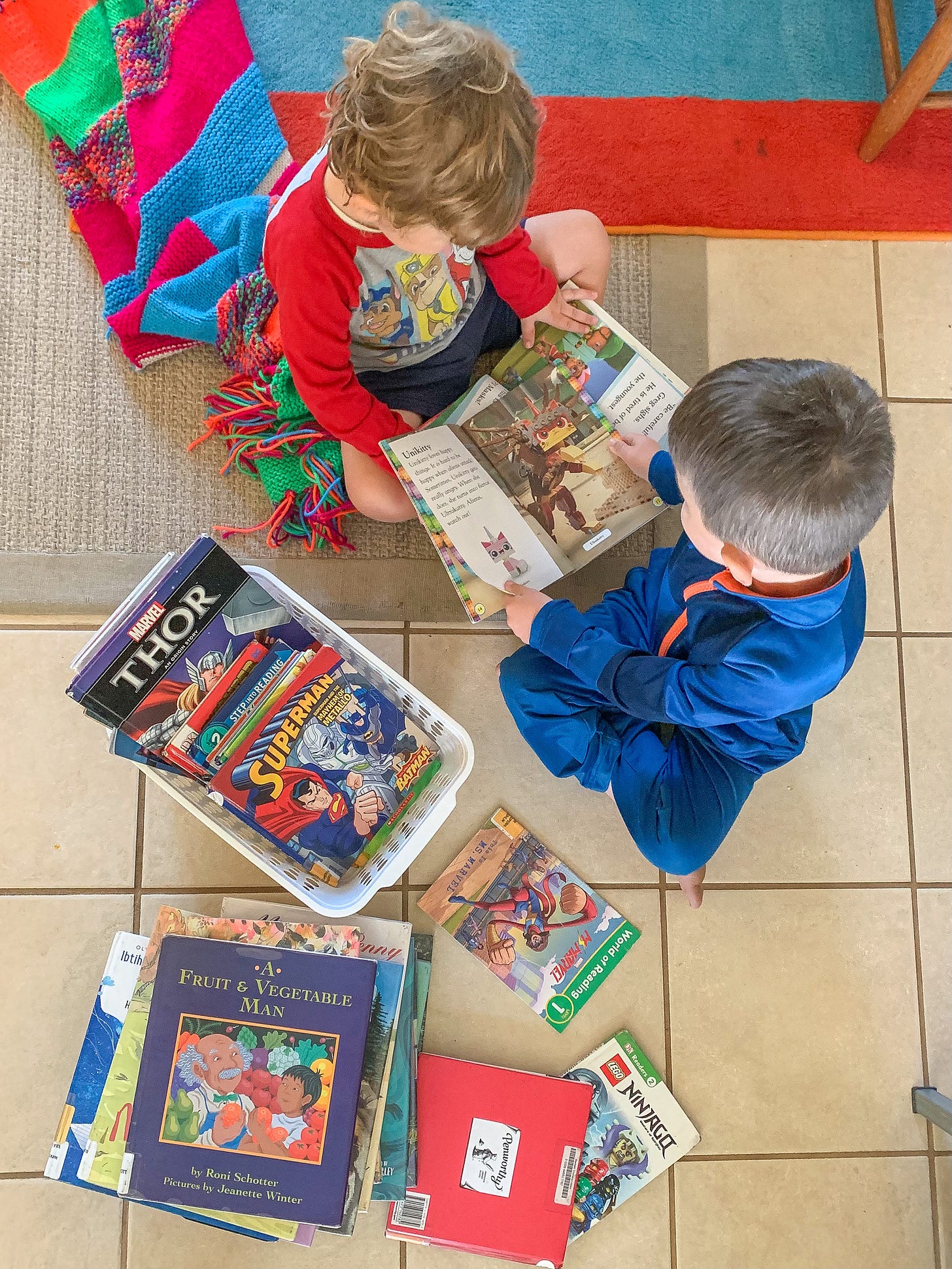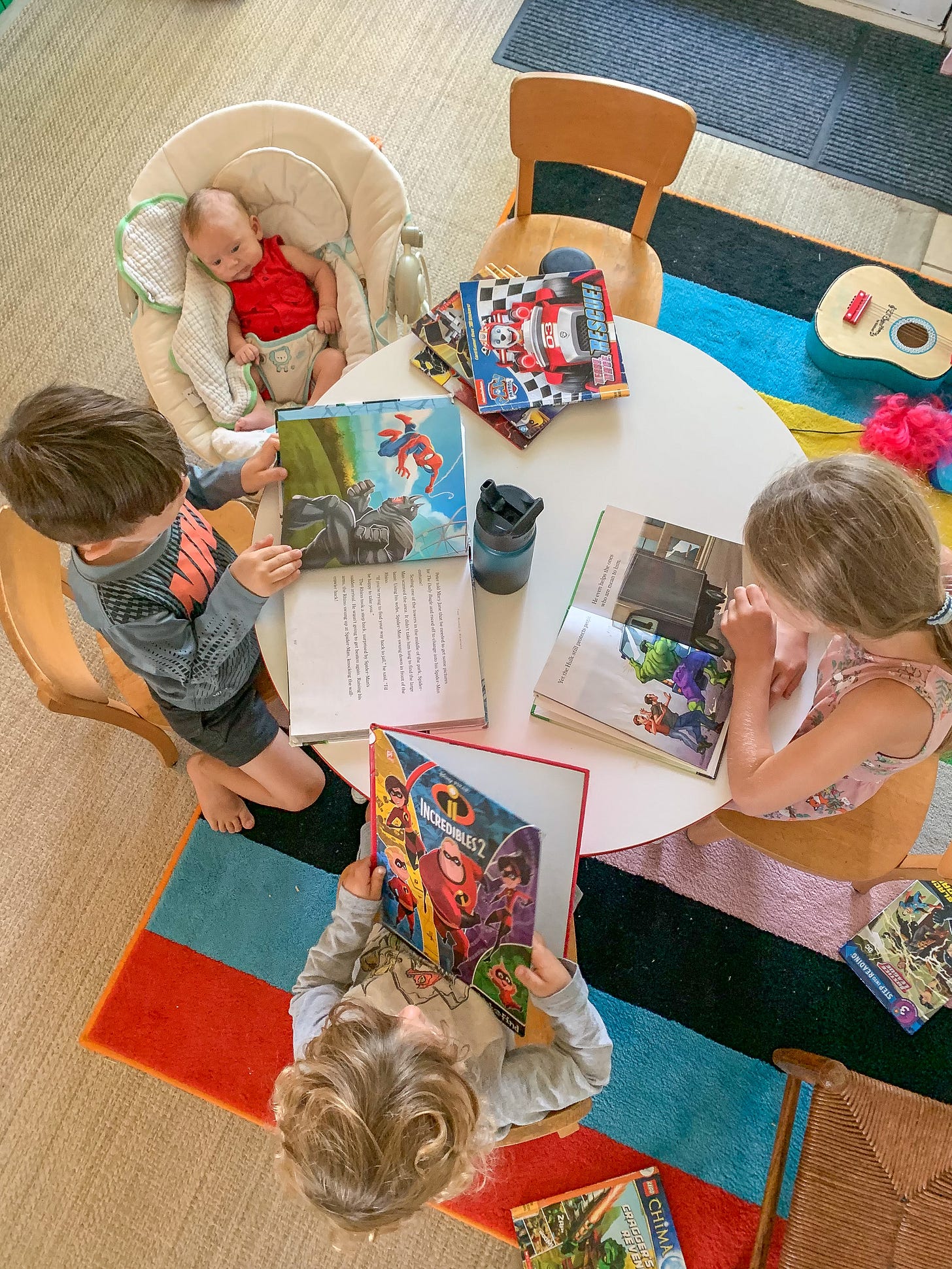How to Teach Your Child to Read- Part 1: The Preschool Years
This is another one of my “How to Homeschool” series posts that I’ll be sharing over the summer. Stay tuned for more of these if you’re a homeschooling family! This fall, I’d love to begin compiling a “Homeschooling Guidebook” that will contain thoughtful answers from homeschooling mamas with tips, experience, and resources. Here’s what I need! If you have a homeschooling blog or Substack and would like to collaborate with me in this Homeschooling Guidebook, please send me a message or leave a comment!
Whenever I hear from someone who's even a little interested in homeschooling, there's one fear that comes up more than anything else. It's the reason they hesitate, the thing that makes them nervous to dive in…
"But how do I actually teach my child to read? I’m not trained like a teacher—I don’t want to mess it up!"
I’ve heard it countless times. And I get it—teaching a child to read can feel intimidating! But I’m here to encourage you and tell you that you absolutely can do this. Regardless of your child’s personality, learning style, or your own educational background, you are uniquely equipped for the job. As their parent, you’re their greatest advocate and the one who knows and loves them best.
Reading is a Basic Human Skill
Reading isn’t something that just clicks automatically, like learning to feed oneself or use the potty. It’s a skill built slowly through practice, patience, and pattern recognition. It takes time, and that’s normal.
But here’s the encouraging part—learning to read is one of the most widespread and successful human achievements in history. For thousands of years, children have learned to read without formal training programs or degrees. Literacy isn’t a mystery, and it isn’t reserved for experts. With the right tools and consistency, any child (barring true learning challenges) can learn to read—and thrive.
My college cross country coach had a saying I still think about today— “It’s not rocket science. It’s consistency.” That idea applies perfectly here. Teaching reading isn’t about having a grand master plan—it’s about steady, repeated effort over time.
In Part 1 of this series, I’ll focus on the preschool years. These early years are all about building a rich foundation for future reading success—sparking curiosity, nurturing language, and making books a joyful part of everyday life.
In Part 2, I’ll walk you through a clear, phonics-based process I’ve used with hundreds of children (including my own!) that leads to confident, capable readers—and book lovers for life.
10 Early Literacy Practices to Help Lay a Strong Reading Foundation
1. Read aloud every day, even before they fully understand.
I started reading to my babies long before they could even sit up, and I’m convinced those early snuggles with our favorite board books planted the seeds of enjoyment years down the road.
A simple way of incorporating reading each day is to pick predictable points in your schedule— at the breakfast table, before or after a nap, during snack time, before bed. That way, it becomes a habit and something to look forward to.
2. Re-read the same books (even the ones you’re tired of!).
I’ve read Llama Llama Nighty-Night and Little Blue Truck more times than I can count by now (and have memorized them!). But each time, my kids hear patterns, rhythms, and vocabulary that are laying the groundwork for future reading skills. Repetition is how they learn and a big step forward with being able to read by themselves. So re-reading the same books over and over again doesn’t have to be boring when the benefits that come from it are substantial!
3. Learn nursery rhymes together.
I began teaching nursery rhymes to my kids during our first year of homeschooling using this great book that we still use today. These silly rhymes may seem old-fashioned, but train their young ears to hear the smaller sounds inside words (like rhyming words, alliterations, and syllables), called phonemic awareness— a big skill needed later on when learning about word parts.
4. Talk about the sounds words make.
This is such a simple habit, but it really adds up in inviting young kids to think about the sounds that words make. As we’re reading together, I’ll say things like, “Did you hear that? ‘Sun’ starts with the ‘ssss’ sound,” or, “Mango has the “mmm” at the beginning—just like your brother Milo!”
These little opportunities help kids start noticing that words are made up of smaller sounds, not just whole units. Being aware of this (called phonemic awareness) is one of the very first steps toward reading. It doesn’t require any flashcards or curriculum, just a little play in your everyday conversations.
5. Point out letters in the real world.
We try to find letters everywhere—on cereal boxes, road signs, at the grocery store, at the park. I’ll say things like, “Look! There’s an ‘L’ just like in Leo!” It’s a fun way to help them see that letters have meaning and they’re all around us. It doesn’t take long before they’re doing this little game on their own!
6. Let them play with letters.
Giving your child chances to play with letters helps them become familiar with the shapes and names in a natural, hands-on way. Whether it’s magnetic letters on the fridge, foam letters in the tub, Banana-Gram tiles in a sensory bin, or wooden stencils to trace, that repeated exposure builds comfort and recognition—before any formal instruction is done.
7. Set up books around the house.
I wish I had learned this sooner with my first—less focus on toys, more on books. Now, we keep shelves or baskets of good-quality picture books in nearly every room. Having books at eye level creates a quiet invitation to read, and the more often kids see them, the more likely they are to reach for them.
8. Make up stories together.
Over the years, one of my kids’ favorite things to do is ask me to “tell them a story”. Whether real or totally made-up and silly, it always has a beginning, middle, and end, and typically involves story elements such as a scary part, sad part, and funny part. This builds imagination, story structure, and a love of for engaging stories— which all lead to greater reading and writing success later on.
9. Play sound and rhyme games.
When there’s some down time, like in the car or as we’re waiting in line, I like to play little rhyming and sound games with my kids. I’ll say something like, “What rhymes with cat?” or “Can you think of a word that starts with ‘b’?” or “I’m going to tap out the sounds I hear in a word and you tell me what word it is, ‘m’ ‘o’ ‘p’”. These games build phonemic awareness in a playful way which shows kids that learning to read can be fun.
10. Keep it enjoyable.
But the most important part of introducing your preschooler how to read is this— don’t stress. If your child doesn’t love books yet, it’s okay. They’re not doomed to be a reluctant or struggling reader. The goal at this stage isn’t to have them reading on their own, but laying a foundation that introduces them to stories, words, and sounds in a playful, enjoyable way.
Find books that they’re interested in and start there. Build slowly and make reading as fun as you can (snuggling with blankets, having a tea party with snacks, reading outside). You want them to feel confident leading up to the school-age years of reading instruction instead of dreading every time a book is cracked open.
One Final Note
These early years are all about planting seeds of curiosity, confidence, and connection with your child— so there should be no pressure or expectations for anything formal until age 5 or 6.
You don’t need a teaching degree or a perfect routine, just keep reading, playing, and talking together. Gradually, those small moments will grow into something meaningful. And when the time comes to start formal reading lessons, you’ll both be ready and equipped.
Stay tuned for Part 2 of “How to Teach Your Child to Read”, where I’ll share my experience of teaching reading as a first-grade public school teacher and now a homeschool mom!
And as always, thank you so much for being here. If you enjoyed this post and found it helpful, I’d be so grateful if you shared it with someone else who also could benefit from it!






Thank you for talking about the early foundations, too many just expect littles to learn names of letters, open a book and start reading at 6. It happens nowhere near like that!
Mollie, your posts are top notch quality information! What wonderful strategies and realistic ways to help our preschoolers learn to read. It’s so fun I get to do it again with the grandkids! 💕